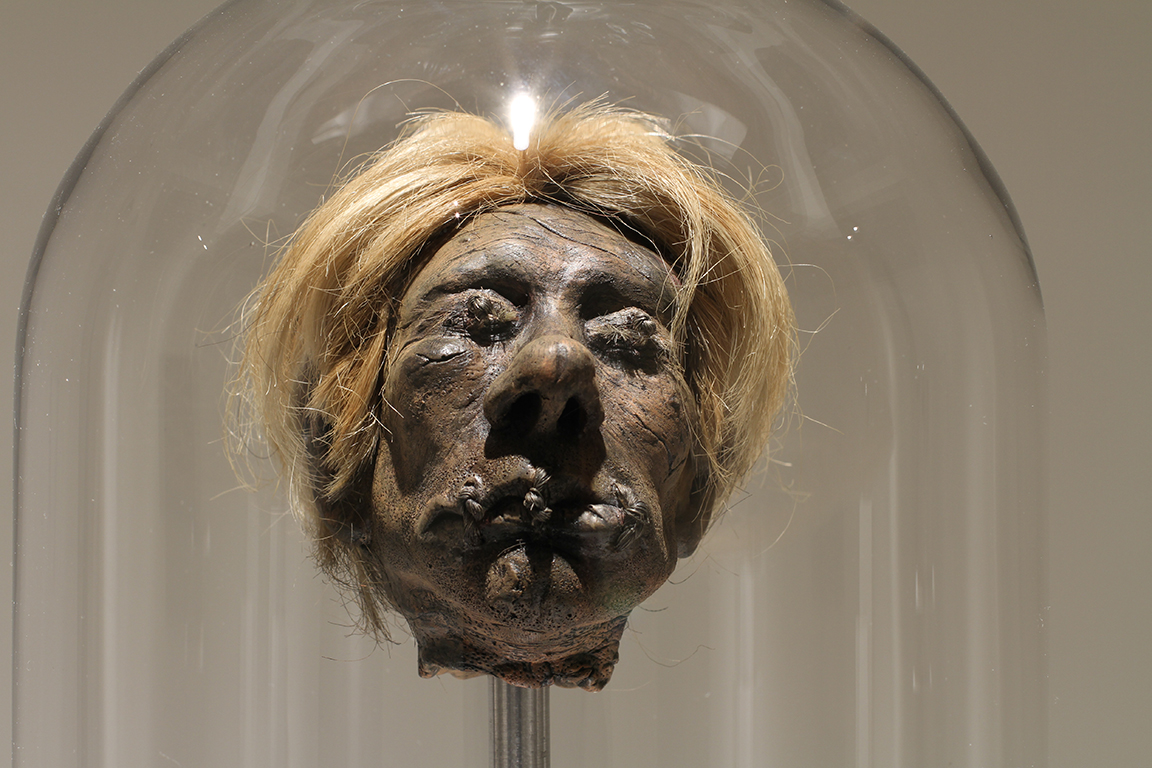With the pervasive yet varied theme of the human body, Art Mûr’s latest exhibitions push the social boundaries of comfort and originality. A striking feature of this free contemporary art gallery and studio is its intimate layout, which immediately takes hold of visitors ,and forces them into a new mindset upon entering.
After the first step into the gallery, one is within arm’s reach of an overwhelming piece from Sonny Assu’s #NEVERIDLE exposition. Half of the pieces use drums as a medium, while the other half use unique geometric forms; all, however, are made from real caribou skin. The canvas’ uncommon shapes amplify the abstract patterns’ ambiguity, causing the piece in entirety to reflect personal projections, which may include immense sadness, jocularity, or harmony depending on the viewer. Although well-made and interesting, this exhibit seems like an art class’ textbook definition of abstract art; it does not have anything to distinguish itself from countless past works in the same genre.
The exhibition’s narrow hallway opens up into a room containing Bevan Ramsay’s unsettling (to put it mildly) Soft Tissue. This white room contains four paintings and five sculptures, devoted to displaying meat in ways people would not usually like to think of it. The red paintings portray slabs of meat at different distances—from large, thick, whole pieces, to the meat’s structure at cellular level. These pieces complement the exhibition well, but are not nearly as attention-grabbing nor emotive as Soft Tissue’s sculptures.
Thankfully not made of real meat, the sculptures combine various parts of humans and animals into deformed monstrosities. The first piece features a human with bloody pig hooves for hands, kneeling down, appearing to worship the rest of the exhibit. Directly in front of this creature is what appears to be a massive chicken wing with a graphic, gory gash in its side. The wing stands on a beautifully accurate hand. At about eye level, the wing has an open human mouth, reminding the viewer of what one typically does with chicken wings. Whether a statement about vegetarianism, the similarities of man and beast, or simply an attempt to make viewers as uncomfortable as possible, this exhibit’s careful attention to detail—no matter how nauseating—evokes a strong emotional response.
The final room of the first floor contains Renato Garza Cervera’s Springbreaker Tsantsas—a basic display of nine shrunken heads with a video of a child holding several others on string. Each head within a glass jar on a podium, this sterile exhibit does not possess any of the previous room’s impact. One would think that shrunken heads would be more spine-tingling, but, perhaps because only their hair is actually human, they did not elicit any emotional impact. The heads are surprisingly small, about the size of a fist, and look metallic with a few cracks spread across the face. Perhaps somebody with a greater pre-existing affinity for shrunken heads would experience an enhanced appreciation for these pieces, but it certainly did not create one for this critic.
This series aims to create an emotional response, and in some sense, it does succeed. But simply being visceral or ambiguous isn’t enough to be inspiring.
Art Mûr’s current exhibitions are on display until Apr. 27 (5826 rue St-Hubert). Admission is free.









